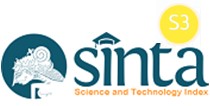The relationship between social capital and food security in farmer households (case study: Sedayulawas Village, Lamongan Regency – Indonesia)
Abstract
Full Text:
PDFReferences
[1] Purba H, Yusuf E, Erwidodo. DAMPAK PANDEMI COVID-19 TERHADAP PERTUMBUHAN EKONOMI DAN SEKTOR PERTANIAN, 2020, p. 23–46.
[2] Badan Pusat Statistik. Profil Kabupaten Lamongan. Profil Kabupaten Lamongan, 2021, p. 144.
[3] Amrozi R. Lamongan Dijadikan Pilot Project Penanganan Kemiskinan Ekstrim. Berita Satu 2021. https://www.beritasatu.com/nasional/833149/lamongan-dipilih-jadi-pilot-project-penanganan-kemiskinan-ekstrem-nasional (accessed July 16, 2023).
[4] BPS Kabupaten Lamongan. Kabupaten Lamongan Dalam Angka 2021. Kabupaten Lamongan: BPS Kabupaten Lamongan; 2021.
[5] Muntalim M, Purnamasari I, Rosyidah NK. STRATEGI PENGEMBANGAN USAHA GARAM DENGAN METODE RUMAH GARAM PRISMA DI DESA SEDAYULAWAS KECAMATAN BRONDONG KABUPATEN LAMONGAN. Grouper 2020;11:1. https://doi.org/10.30736/grouper.v11i1.68.
[6] Fadli R. PARTISIPASI PEMUDA KARANG TARUNA MAHARDIKA DALAM PEMBANGUNAN DESA JUBEL KIDUL KECAMATAN SUGIO KABUPATEN LAMONGAN. Nurani: Jurnal Kajian Syari’ah Dan Masyarakat 2019;19:91–102. https://doi.org/10.19109/nurani.v19i1.3059.
[7] Endarwati S, Wahyuni ES. The Impact of Social Capital on Horticultural Farmer Household Food Security in Ciaruteun Ilir Village Cibungbulang Sub-district Bogor Regency. Jurnal Penyuluhan 2014;10.
[8] Fadhila Rasyid N, Halil A. PERAN MODAL SOSIAL DALAM USAHATANI RUMPUT LAUT DI DESA BONTOSUNGGU KECAMATAN TAMALATEA KABUPATEN JENEPONTO. Jurnal Sosial Ekonomi Pertanian Dan Agribisnis 2022;2.
[9] Fathy R. Modal Sosial: Konsep, Inklusivitas dan Pemberdayaan Masyarakat. Jurnal Pemikiran Sosiologi 2019;6:1. https://doi.org/10.22146/jps.v6i1.47463.
[10] Aziza TN. Upaya Penguatan Kelembagaan Pangan. Jurnal Ekonomi Pertanian Dan Agribisnis (JEPA) 2019;3.
[11] Prayitno G, Maulida RF B, Nugraha AT. Modal Sosial, Ketahanan Pangan dan Pertanian Berkelanjutan Desa Ngadireso, Indonesia. Region: Jurnal Pembangunan Wilayah Dan Perencanaan Partisipatif 2019;14:229. https://doi.org/10.20961/region.v14i2.30018.
[12] Kirkpatrick SI, Tarasuk V. Assessing the relevance of neighbourhood characteristics to the household food security of low-income Toronto families. Public Health Nutr 2010;13:1139–48. https://doi.org/10.1017/S1368980010000339.
[13] Kismul H, Hatløy A, Andersen P, Mapatano M, Van den Broeck J, Moland KM. The social context of severe child malnutrition: a qualitative household case study from a rural area of the Democratic Republic of Congo. Int J Equity Health 2015;14:47. https://doi.org/10.1186/s12939-015-0175-x.
[14] Wong KK-K. Partial Least Squares Structural Equation Modeling (PLS-SEM) Techniques Using SmartPLS. Marketing Bulletin 2013;24.
[15] F. Hair Jr J, Sarstedt M, Hopkins L, G. Kuppelwieser V. Partial least squares structural equation modeling (PLS-SEM). European Business Review 2014;26:106–21. https://doi.org/10.1108/EBR-10-2013-0128.
[16] Gye-Soo K. Partial Least Squares Structural Equation Modeling(PLS-SEM): An application in Customer Satisfaction Research. International Journal of U- and e- Service, Science and Technology 2016;9:61–8. https://doi.org/10.14257/ijunesst.2016.9.4.07.
[17] Gitleman L, Purnomo E, Suhendra ES, Fathy R. Data dan metode pengumpulan data penelitian. Sodality: Jurnal Sosiologi Pedesaan 2019;5.
[18] Hunecke C, Engler A, Jara-Rojas R, Poortvliet PM. Understanding the role of social capital in adoption decisions: An application to irrigation technology. Agric Syst 2017;153:221–31. https://doi.org/10.1016/j.agsy.2017.02.002.
[19] Nunkoo R, Ramkissoon H. Structural equation modelling and regression analysis in tourism research. Current Issues in Tourism 2012;15:777–802. https://doi.org/10.1080/13683500.2011.641947.
[20] Hair JF, Hult GTM, Ringle CM, Sarstedt M. A Primer on Partial Least Squares Structural Equation Modeling (PLS-SEM). Thousand Oaks. 2nd Ed. Sage; 2017.
[21] Ulum M, Tirta Im. Analisis structural equation modeling untuk sampel kecil dengan pendekatan partial least square. Prosiding Seminar Nasional Matematika 2014;1.
[22] Fukuyama F. Social Capital and Development: The Coming Agenda. SAIS Review 2002;22:23–37. https://doi.org/10.1353/sais.2002.0009.
[23] Badan Ketahanan Pangan Kementerian Pertanian. Direktori Konsumsi Pangan Seri 20 Revisi. Badan Ketahanan Pangan Kementerian Pertanian 2020.
[24] Utami Q, Suprapti I. FAKTOR MODAL SOSIAL TERHADAP KETAHANAN PANGAN RUMAH TANGGA PETANI JAGUNG LOKAL DESA GULUK GULUK KABUPATEN SUMENEP. AGRISCIENCE 2020;1:138–50. https://doi.org/10.21107/agriscience.v1i1.7972.
[25] Prayitno G, Hayat A, Efendi A, Tarno H, Fikriyah, Fauziah SH. Structural Model of Social Capital and Quality of Life of Farmers in Supporting Sustainable Agriculture (Evidence: Sedayulawas Village, Lamongan Regency-Indonesia). Sustainability 2022;14:12487. https://doi.org/10.3390/su141912487.
[26] Nugraha A, Prayitno G, Rahmawati R, Auliah A. Farmers’ Social Capital in Supporting Sustainable Agriculture: The Case of Pujon Kidul Tourism Village, Indonesia. Civil and Environmental Science 2022;005:235–49. https://doi.org/10.21776/ub.civense.2022.00502.12.
[27] PRAYITNO G, HAYAT A, EFENDI A, AULIAH A, IKBAR FARRAH A. STRUCTURAL EQUATION MODEL THE DEVELOPMENT OF THE COVID 19 COMMUNITY RESILIENCE IN PUJON KIDUL TOURISM VILLAGE. GeoJournal of Tourism and Geosites 2022;43:925–36. https://doi.org/10.30892/gtg.43312-906.
[28] Nosratabadi S, Khazami N, Abdallah M Ben, Lackner Z, S. Band S, Mosavi A, et al. Social Capital Contributions to Food Security: A Comprehensive Literature Review. Foods 2020;9:1650. https://doi.org/10.3390/foods9111650.
[29] Devereux S, Béné C, Hoddinott J. Conceptualising COVID-19’s impacts on household food security. Food Secur 2020;12:769–72. https://doi.org/10.1007/s12571-020-01085-0.
[30] BPS Statistic Indonesia. Indeks Ketahanan Pangan. BPS Statistic Indonesia 2016.
[31] Krejcie R V., Morgan DW. Determining Sample Size for Research Activities. Educ Psychol Meas 1970;30:607–10. https://doi.org/10.1177/001316447003000308.
[32] Setyawan DA. Data dan Metode Pengumpulan Data Penelitian. Politeknik Kesehatan Surakarta 2013:9–13.
[33] Muhson A. Analisis Statistik Dengan SmartPLS. Universitas Negeri Yogyakarta 2022.
Refbacks
- There are currently no refbacks.


.png)

.jpg)









